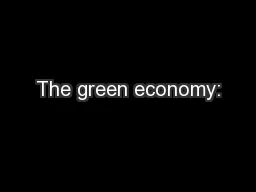PPT-Making green mutation of the economy an opportunity for loc
Author : tatyana-admore | Published Date : 2017-05-31
Transnational Event 3 Albacete 16 March 2011 Olivier PIHAN Deputy Manager MEF du Pays de la région mulhousienne opihanmefmulhousefr Tel 00 33 03 89 54 40 01 Summary
Presentation Embed Code
Download Presentation
Download Presentation The PPT/PDF document "Making green mutation of the economy an ..." is the property of its rightful owner. Permission is granted to download and print the materials on this website for personal, non-commercial use only, and to display it on your personal computer provided you do not modify the materials and that you retain all copyright notices contained in the materials. By downloading content from our website, you accept the terms of this agreement.
Making green mutation of the economy an opportunity for loc: Transcript
Download Rules Of Document
"Making green mutation of the economy an opportunity for loc"The content belongs to its owner. You may download and print it for personal use, without modification, and keep all copyright notices. By downloading, you agree to these terms.
Related Documents














